Human Orbital Spaceflights
![]()
International Flight No. 70Soyuz 36Soyuz 35OrionUSSR |
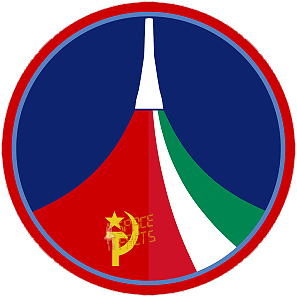 |
 |
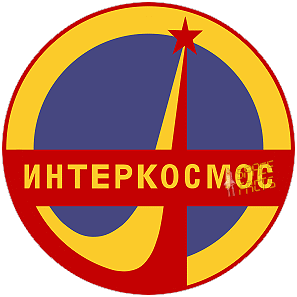 |
 |
|
![]()
Launch, orbit and landing data
walkout photo |
 |
|||||||||||||||||||||||||||||||
alternative crew photo |
alternative crew photo |
|||||||||||||||||||||||||||||||
alternative crew photo |
alternative crew photo |
|||||||||||||||||||||||||||||||
alternative crew photo |
alternative crew photo |
|||||||||||||||||||||||||||||||
Crew
| No. | Surname | Given names | Position | Flight No. | Duration | Orbits | |
| 1 | Kubasov | Valeri Nikolayevich | Commander | 3 | 7d 20h 45m 44s | 124 | |
| 2 | Farkas | Bertalan "Bertsi" | Research Cosmonaut | 1 | 7d 20h 45m 44s | 124 |
Crew seating arrangement
|
 |
|
||||||||||||
Backup Crew
|
 |
|||||||||||||||
alternative crew photo |
||||||||||||||||
alternative crew photo |
Hardware
| Launch vehicle: | Soyuz-U (No. P15000-226) |
| Spacecraft: | Soyuz 36 (7K-T No. 52) |
Flight
|
Launch from the Baikonur Cosmodrome and
landing with Soyuz 35 capsule 180 km
southeast Dzheskasgan. Soyuz 36 was the fifth Intercosmos mission (with Bertalan Farkas, the first cosmonaut from Hungary). Following a one-day solo flight Soyuz 36 docked with the Salyut 6 space station on May 27, 1980 and the crew performed common work with the fourth resident crew. The visit of Soyuz 36 had been preceded a month earlier by the unmanned automatic Progress 9 craft, which contained around 2,900 pounds (1,315 kg) of cargo including food, 180 liters of water, clothing, dust collectors, regeneration equipment, spare parts, tools, scientific instruments, film and mail, and some scientific instruments to be used by the visiting crew of Soyuz 36. It also brought up a new motor for the Biogravstat centrifuge and gas filters for the station's control system. The mission was postponed from June 1979 because of the Soyuz 33 main engine failure. Experiments in materials science and earth observation were carried out. One experiment was Pille, which measured radiation doses received by the crew with miniature thermoluminescent devices attached to their clothing and to the walls of the station. Another three experiments studied the formation of interferon in human cells under weightless conditions. Earth resources work using the on-board cameras were carried out, in coordination with ground crews, airplanes and helicopters. Valeri Kubasov and Bertalan Farkas photographed over 60 percent of the area of Hungary using the MKF-6M camera, while at the same time an Antonov AN-30 laboratory airplane filmed the same area from an altitude of four to five miles (6.4 to 8.0 kilometers). As well, four types of film were taken from helicopters flying between 5,000 and 8,000 feet (1,524 and 2,438 meters) above the ground. Heat-sensing devices also took measurements. The MKF-6M was not simply a matter of point and shoot; first the camera had to be primed, then the Salyut station had to be oriented to aim the camera directly at the ground when the photograph had to be taken. The international crew obtained new data by performing technological experiments on the Kristall and Splav electric-heating installations. These experiments, aimed at the further study of melting, diffusion and crystallization in conditions of weightlessness, were considered to be of great importance for improving the technological processes in series production of new semiconducting materials and for the further development of electronics. The Soyuz craft was used to boost the station's orbit on May 29, 1980, then Valeri Kubasov and Bertalan Farkas swapped Soyuz craft with the long-duration crew, exchanging seat liners, pressure suits and personal items, before departing the station in Soyuz 35 on June 03, 1980. The Soyuz spacecraft is composed of three elements attached end-to-end - the Orbital Module, the Descent Module and the Instrumentation/Propulsion Module. The crew occupied the central element, the Descent Module. The other two modules are jettisoned prior to re-entry. They burn up in the atmosphere, so only the Descent Module returned to Earth. The deorbit burn lasted 188 seconds. Having shed two-thirds of its mass, the Soyuz reached Entry Interface - a point 400,000 feet (121.9 kilometers) above the Earth, where friction due to the thickening atmosphere began to heat its outer surfaces. With only 23 minutes left before it lands on the grassy plains of central Asia, attention in the module turned to slowing its rate of descent. Eight minutes later, the spacecraft was streaking through the sky at a rate of 755 feet (230 meters) per second. Before it touched down, its speed slowed to only 5 feet (1.5 meter) per second, and it lands at an even lower speed than that. Several onboard features ensure that the vehicle and crew land safely and in relative comfort. Four parachutes, deployed 15 minutes before landing, dramatically slowed the vehicle's rate of descent. Two pilot parachutes were the first to be released, and a drogue chute attached to the second one followed immediately after. The drogue, measuring 24 square meters (258 square feet) in area, slowed the rate of descent from 755 feet (230 meters) per second to 262 feet (80 meters) per second. The main parachute was the last to emerge. It is the largest chute, with a surface area of 10,764 square feet (1,000 square meters). Its harnesses shifted the vehicle's attitude to a 30-degree angle relative to the ground, dissipating heat, and then shifted it again to a straight vertical descent prior to landing. The main chute slowed the Soyuz to a descent rate of only 24 feet (7.3 meters) per second, which is still too fast for a comfortable landing. One second before touchdown, two sets of three small engines on the bottom of the vehicle fired, slowing the vehicle to soften the landing. |
Relocations of Manned Spacecrafts
| Spacecraft | from | Undocking | Time UTC | to | Redocking | Time UTC |
| Soyuz 36 | Salyut 6 - aft port | 04.06.1980 | 16:39 | Salyut 6 - front port | 04.06.1980 | 17:09 |
Photos / Graphics
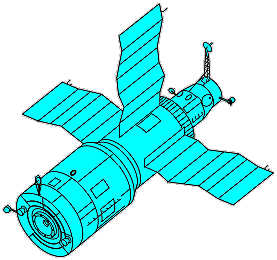 |
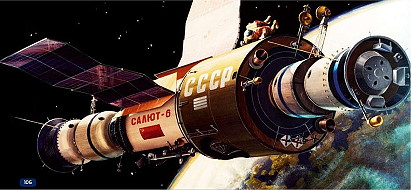 |
 |
 |
 |
 |
 |
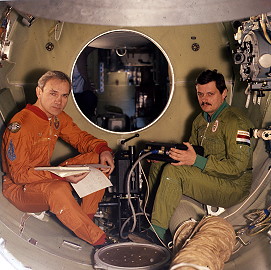 |
 |
 |
 |
 |
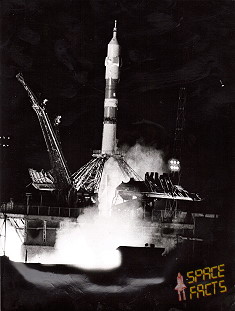 |
 |
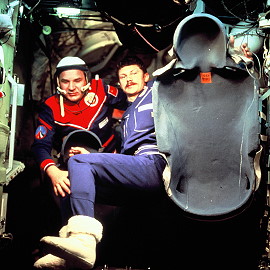 |
 |
 |
 |
 |
 |
| © |  |
Last update on May 14, 2021.  |
 |